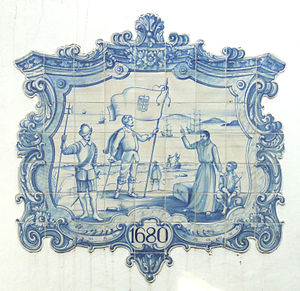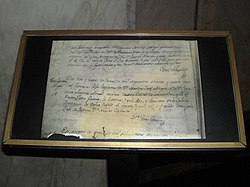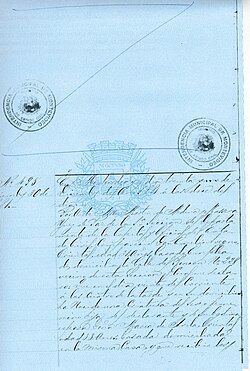
Uruguayan genealogy involves the study of one's ancestors in Uruguay. There is a significant number of historical records in Uruguay, with some available since the mid-1700s, like civil registration records, church records, and others, to help the avid genealogist explore one's Uruguayan heritage.
History of Uruguayan genealogy
Uruguayan genealogy during the Spanish Colonization
The development of genealogy in Uruguay was practically non-existent since the colonial era and until the first century after independence from Spain. With the exception of some historians such as Isidoro de María in his Rasgos biográficos de hombres notables (“Biographical traits of notable men”), or some isolated case of intellectuals who had the concern to investigate their genealogy, such as Antonio Pereira who published Casas de Antaño (“Houses of Yore”) in 1895,[1] there was no interest in society to know their family roots. Many factors contributed to this lack of knowledge or disinterest in genealogy. First of all, genealogy was conceived as an aristocratic, elitist discipline, exclusive of royal houses or noble classes; only the nobles had genealogy, and the common people viewed with contempt and suspicion everything related to birth privileges or titles acquired by royals. Secondly, what is known today as Uruguay, was once “land without any benefit.”. At the beginning of the 17th century, it was the premonitory vision of Hernando Arias de Saavedra, he first person born in the Americas to become a governor of a European colony in the New World, who appreciated the promising fertility of the Banda Oriental, the South American territories east of the Uruguay River and north of Río de la Plata that eventually became Uruguay, and laid the foundations for a new material and cultural foundation with the introduction of livestock. and the promotion of the evangelizing work of the Jesuit missions. From then on, the Banda Oriental transformed from a despised “land of no use” into a rich cattle land, with its first settlers coming from the Jesuit Missions in present-day Rio Grande do Sul (Brazil) and farm workers who came from Santa Fe and Buenos Aires to trade livestock. But, equally, and attracted by this livestock wealth, the bandeirantes would soon arrive, forged in the Portuguese-Indigenous-African mixture of the São Paulo area who, in repeated raids, herded large contingents of cattle to their territories. Of course, during the Iberian Union, the dynastic union of Spain (Castile and Aragon) and Portugal between 1580 and 1640, such incursions were not punishable since the bandeirantes were Castilian subjects. But, once the separation of Portugal from the Kingdom of Castile was completed, their enterprises became an aggression of dispossession and pillage in foreign territory. The new geopolitical situation then determined the clash and conflict between the intrepid Brazilian subjects of the Portuguese king and the Tapés countrymen of the Jesuit Missions, subjects of the Castilian king of the Indies. From then on, the then “Banda Vaquería” became a conflictive “back-and-forth border” between the two rival Iberian kingdoms.

Spain's interest in the Eastern Band of La Plata River only began as a counterpart to the Portuguese advance at the end of the 17th century. Unlike the other capitals of the current Latin American countries, which were founded during the reign of Charles V and Philip II (1519-1598), Montevideo was born as a response to the Portuguese advances in 1726. This chronological difference and the consequent short period of Spanish domination avoided consolidating social differences of notoriety as in other American territories. This has caused Uruguay to be the last American region to join the Spanish Empire, which allowed the formation of a more egalitarian society outside of privileges and titles of nobility. In the absence of settling families from Buenos Aires or the Argentinian coast, it was necessary to turn to metropolitan settlers and, in this sense, the order of August 1726 issued by the governor of Buenos Aires, Mr. Bruno Mauricio de Zabala, offered the best possible conditions for settlers from the Canary Islands who would arrive at the end of that year. In this order, among other perks contained, it adds: “to honor the legitimate children and descendants of those who are obliged to establish a population and have completed it and fulfilled their position, we will make them sons of known land so that in that population and any other parts of the Indies are noble sons and noble people of known lineage and estate and as such they are born and held and we grant them the honors that the hidalgos and knights of the Kingdom of Castile should have and enjoy, according to the jurisdictions, laws and customs of Spain.”
While the Canarian founding settlers in Montevideo were made hidalgos, a lesser nobility title in the Iberian Peninsula, by the Crown of the Indies, practically none of them or their descendants ever made use of this privilege, as the city was run in a relatively egalitarian way. Over time, the so-called main families were formed and emerged over the years, they also remained prototypes of a democratic bourgeoisie without class differences.[1] This way, the early-days montevidean society started to develop with the double contribution of the Hispanic noblemen from the Canary Islands and the mission-educated Tapes of Guaraní origin, with which they began the founding feat of the newest country in Hispanic America..[2]
In this way, the first Uruguayans developed the wild country and turned it into productive land with new population centers under the tutelary sight of the Catholic Church and connected by the Spanish language they shared. Similarly, the system of livestock production brought together both the large landowners and the rural laborers, all of whom were aware of the misery and sacrifices of rural work, which was very different to other colonies where there were gold or silver mines, plantations or encomiendas, where their economic infrastructure determined stratified societies subject to social differentiation, which contrasted with the oligarchies in the port city of Montevideo, which were in for hegemony.
Uruguayan genealogy after independence

The first Constitution of Uruguay, adopted in 1830, enshrined the principle of equality by establishing that all people are equal before the law, thus abolishing nobility and hereditary distinctions like the hidalguía system. As the country developed, immigrants from Europe began to arrive, overcoming the local population, which created the “Uruguayan” identity by the integration of the Hispanic-Creole locals with the ”gringos”, as the immigrants were generically called. In the face of the breakdown of the founding identity, an intellectual movement emerged from the ruling class, seeking to learn about their roots in order to differentiate itself from the new arrivals. This sparked an interest in Uruguay for genealogy.
Uruguayan genealogy in modern times
The first genealogical writings began to be published in Uruguay in the 1920s, with Ramón Llambías de Olivar publishing his genealogical work of the lineage of the national hero D. José Gervasio Artigas between 1923 and 1925. One year later, Luis Enrique Azarola Gil published “Veinte linajes del siglo XVIII,” followed by “Crónicas y linajes de la Gobernación del Plata” in 1936, “Los San Martín en la Banda Oriental” in 1940, “Azarola. Crónica del linaje” as well as “Los Maciel in the History of Plata” in 1940, and “Apellidos de la Patria Vieja” in 1942.
Coinciding with Azarola's death in 1966, a naturalized Uruguayan German citizen published the greatest work published up to that time: the monumental “Genesis of the Uruguayan Family.” Its author: Juan Alejandro Apolant (1903-1975). Apolant was founder, along with other prominent historians, of the Center for Studies of the Uruguayan Past (CESPAU), the precursor entity of the Institute for Genealogical Studies of Uruguay. This work gained deserved fame for its cyclopean compilation of the first years of the Oriental society (1726-1767). His scientific method led him to search censuses, ecclesiastical and administrative archives, newspapers and various publications, to which he added the results of research carried out in the ]]General Archive of the Indies]]. This work, truly a genealogical monument, is a must-see for every serious researcher who dedicates himself to the study of our discipline. It is worth mentioning two other relevant works by the same author: “Padrones olvidados de Montevideo del siglo XVIII” and “Operativo Patagonia”; In the latter, the author carries out a detailed study of the most important immigration that occurred in the Banda Oriental during the Hispanic period.
In the period that includes the years 1929 and 1979, the date of founding of our institute, the only one of its kind in our country, it is worth mentioning other researchers who, not as relevant to our discipline as Azarola or Apolant, have addressed the genealogical topic. , many of them tangentially as an extension of their vocation as historians. We refer, among others, to Luis Thevenet and his work: “De la estirpe artiguista”, published in 1929, Carlos Real de Azúa with his brilliant work: “El patriciado uruguayo”, Julio Lerena Juanicó “Crónica de un hogar montevideano”, Juan Alberto Gadea, Luis Roberto Ponce de León, Huáscar Parallada, Ariosto Fernández, Justino Zavala Muniz, Alejandro Gallinal or Hubertina de Gomensoro Moyano with their work: “Genealogical Notes”, or the famous biographer José María Fernández Saldaña and his monumental work: “ Uruguayan Dictionary of Biographies 1810-1940”, and many others that we have left in the pipeline.
In 1979, a group of genealogists led by Ricardo Goldaracen founded the Institute of Genealogical Studies of Uruguay, which apart from its research activities, has published a magazine since 1980.
Researching Uruguayan surnames
Uruguayan surnames follow the same format as other Spanish-speaking countries, which was first adopted in the Iberian Peninsula in the XII Century. Native Americans, after being baptized in the Jesuit Misiones, adopted surnames given by their godparents.
Uruguayan records for family research
The available data in Uruguay can be divided into two different categories:
- Primary sources: Church records, civil registrations, censuses, voters list
- Secondary sources: Address books, newspapers and family books.
Uruguayan censuses
INE (Instituto Nacional de Estadística) has digitized census information published in Uruguay since 1963. The census records obtained prior to 1963 are physically available in library of the presidency of the country.
Church records
It is necessary to have a researcher's card (made in the same place) for a duration of one month, which can be renewed as needed, which gives access to the Archives of the Archdiocese of Montevideo, all from the microfilm of parish books.[3]
Other records
At the National Archives (Archivo General de la Nación) it is possible to search for registers and censuses. For some departments, there are records as old as 1726. Some other records, especially newspapers are available at the National Library of Uruguay in Montevideo.
Explore more about Uruguayan genealogy
- The Uruguay - Collection Catalog on MyHeritage contains over one million records divided in the following record collections:
- Uruguay, Civil Registration record collection at MyHeritage
- Uruguay, Baptisms, 1750-1900 record collection at MyHeritage
- Uruguay, Marriages, 1840-1900 record collection at MyHeritage
- The Game That Wrote Three Generations Into History at the MyHeritage blog
- Instituto Nacional de Estadística
- Archivo General de la Nación
- Instituto de Estudios Genealógicos del Uruguay
- Immigrant Ancestors Project. Center for Family History and Genealogy at Brigham Young University
- Newspaper archive at the National Library of Uruguay
- Lists of passengers embarked in Bayonne, on the frigate "Soleil", on November 26, 1835, arriving in Montevideo on February 20, 1836. The records in question correspond to images N°28 to 41.
- Jewish Genealogy in Uruguay
- Montevideo (Uruguay) - Center for Jewish History
References
- ↑ 1.0 1.1 APOLANT, Juan A: “Instantáneas de la época colonial”. Colección “La Sociedad Uruguaya”. Edit.Arca. Montevideo, 1971.
- ↑ REYES ABADIE, Washington: “Españoles en el Uruguay”. Ed.Banda Oriental. Montevideo, 2000.
- ↑ Archdiocese of Montevideo